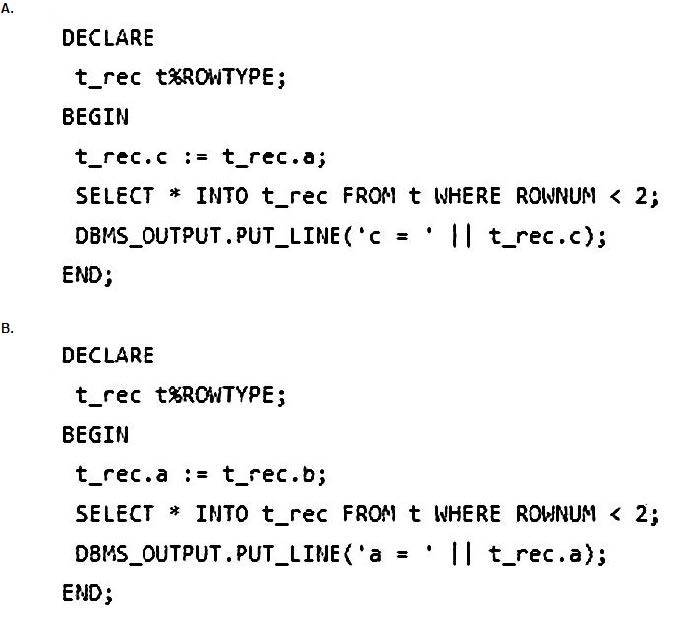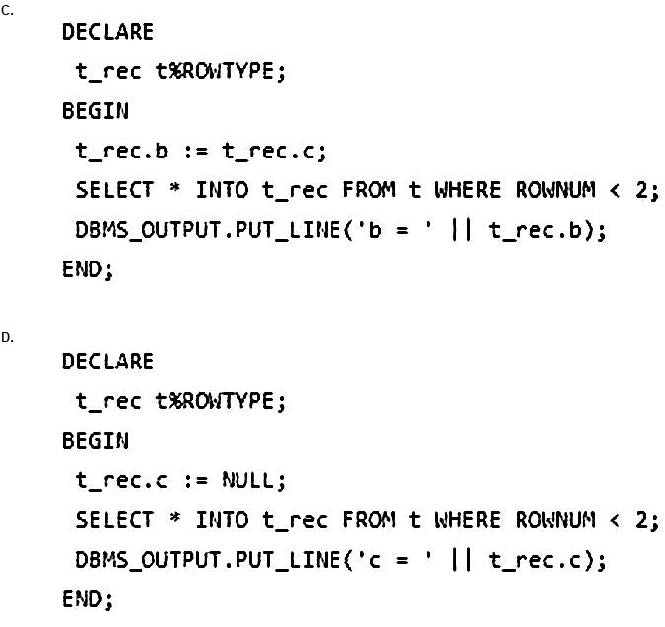Exam Details
Exam Code
:1Z0-149Exam Name
:Oracle Database Program with PL/SQLCertification
:Oracle CertificationsVendor
:OracleTotal Questions
:65 Q&AsLast Updated
:Mar 26, 2025
Oracle Oracle Certifications 1Z0-149 Questions & Answers
-
Question 31:
Which is true about counter variables in a FOR loop?
A. It must explicitly be declared.
B. It can be modified in the body of the loop.
C. It cannot be NULL.
D. It is accessible outside the body of the loop.
-
Question 32:
Which two are true about packages? (Choose two.)
A. Variables and cursors defined in a package specification are visible to all subprograms in the same schema that has the package.
B. Modifications to a packaged procedure's body automatically cause recompilation of subprograms that invoke the procedure.
C. Package specifications can be compiled without their bodies.
D. Standalone subprograms that reference a package can be compiled only after both the package specification and body are compiled.
E. A package definition must have a specification and body.
-
Question 33:
User ORA41 executes these statements successfully:
Now, examine this statement which is executed successfully by user ORA61 after a successful login:
EXECUTE ora41.update_emp_proc(100,25000);
Which two are true? (Choose two.)
A. The salary will be changed for employee 100 in the EMPLOYEES table owned by ORA41.
B. No update happens even though the procedure executes successfully.
C. The salary will be changed for employee 100 in the EMPLOYEES table owned by ORA61.
D. The UPDATE privilege on ORA41.EMPLOYEES is not inherited by ORA61 through the procedure.
E. ORA61 will have been granted the UPDATE privilege explicitly on ORA41.EMPLOYEES before executing the statement.
-
Question 34:
Which two are true about the PLSQL_CODE_TYPE parameter? (Choose two.)
A. Changing the parameter setting automatically changes the setting for existing PL/SQL library units.
B. The default value is NATIVE.
C. If set to NATIVE, programs are stored in platform dependent machine code.
D. It can use the REUSE SETTINGS clause to recompile a program unit without changing to the current session settings.
E. If set to NATIVE, programs are stored in a PL/SQL bytecode format.
-
Question 35:
Sequence S and table PRODUCTS exist in your schema.
Examine the table description:

Now, examine this block of code:

Which two lines each result in a compilation error? (Choose two.)
A. line 1
B. line 6
C. line 8
D. line 2
E. line 3
F. line 7
-
Question 36:
Which three are true about anonymous blocks and subprograms? (Choose three.)
A. Named subprograms cannot be called from other packages.
B. PROCEDURE subprograms can accept parameters.
C. A FUNCTION subprogram must return one or more values.
D. Anonymous blocks cannot use packaged variables.
E. Named subprograms are stored in the database server.
F. Anonymous blocks must always start with the Declare keyword.
G. FUNCTION subprograms must be called and passed through one or more parameters.
-
Question 37:
Examine these statements which execute successfully:

Which anonymous block executes successfully?


A. Option A
B. Option B
C. Option C
D. Option D
-
Question 38:
Which two are true about implicit data type conversion? (Choose two.)
A. RAW data types are always implicitly converted to a CLOB when used in a query.
B. Collections can be implicitly converted to records.
C. ROWIDS are always implicitly converted to a number when used in a query.
D. Comparison between character value and a number value always implicitly converts the character value to the number data type.
E. Implicit data type conversion can negatively impact performance.
-
Question 39:
Which three are true about DDL triggers? (Choose three.)
A. They cannot include the WHEN clause.
B. They must be created in an enabled state.
C. They can be fired when a table is truncated.
D. They fire only when a DDL statement is executed by the owner of the trigger.
E. They can be fired either before or after a DDL statement executes.
F. They can be fired when a privilege is granted to a user.
G. They must be created in a disabled state.
-
Question 40:
Which is true about the PLSCOPE_SETTINGS parameter?
A. It is deprecated in Oracle 12c.
B. It can be used to obtain information about all identifiers when compiling a procedure.
C. It can be used to control execution of specific portions of the PL/SQL code conditionally.
D. It can be used to control a user's privileges on PL/SQL objects at run time.
Related Exams:
1Z0-020
Oracle8i: New Features for Administrators1Z0-023
Architecture and Administration1Z0-024
Performance Tuning1Z0-025
Backup and Recovery1Z0-026
Network Administration1Z0-034
Upgrade Oracle9i/10g OCA to Oracle Database OCP1Z0-036
Managing Oracle9i on Linux1Z0-041
Oracle Database 10g: DBA Assessment1Z0-052
Oracle Database 11g: Administration Workshop I1Z0-053
Oracle Database 11g: Administration II
Tips on How to Prepare for the Exams
Nowadays, the certification exams become more and more important and required by more and more enterprises when applying for a job. But how to prepare for the exam effectively? How to prepare for the exam in a short time with less efforts? How to get a ideal result and how to find the most reliable resources? Here on Vcedump.com, you will find all the answers. Vcedump.com provide not only Oracle exam questions, answers and explanations but also complete assistance on your exam preparation and certification application. If you are confused on your 1Z0-149 exam preparations and Oracle certification application, do not hesitate to visit our Vcedump.com to find your solutions here.